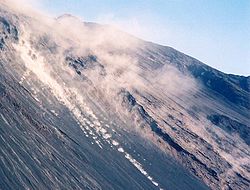Stromboli

| |
| Stromboli | |
|---|---|
| Elevation: | 924 metres (3,031 feet) |
| Coordinates: | Template:Coor d |
| Location: | Aeolian Islands (Italy) |
| Range: | |
| Type: | Stratovolcano |
| Last eruption: | 2006 (continuing) |
| Easiest route: | Hike |
Stromboli is a small island in the Tyrrhenian Sea, containing one of the active volcanos in Italy. It is one of the Aeolian Islands, a volcanic archipelago north of Sicily. This name is a corruption of the ancient Greek name (Στρογγυλή) (Stroŋgulḗ) which was given to it because of its round swelling form.
Stromboli stands 924 m above sea level[1], but actually rises over 2,000m above the ocean floor. There are three active craters at the peak. A significant geological feature of the volcano is the Sciara del Fuoco ("Stream of fire"),a big horseshoe-shaped depression generated in the last 13,000 years by several collapses on the north western side of the cone.
Stromboli is remarkable because of the length of time for which it has been in almost continuous eruption. For at least the last 2,000 years, the same pattern of eruption has been maintained, in which explosions occur at the summit craters with mild to moderate eruptions of incandescent volcanic bombs at intervals ranging from minutes to hours. This characteristic Strombolian eruption, as it is known, is also observed at other volcanoes worldwide. Eruptions from the summit craters typically result in few second-lasting mild energetic burst emitting ash, incandescent lava fragments and lithic blocks up to few hundred meter high. Stromboli's activity is almost exclusively explosive, but lava flows do occasionally occur - an effusive eruption in 2002 was its first in 17 years.
The continuous mildly explosive eruptions are also occasionally punctuated by much larger eruptions. The largest eruption of the last hundred years occurred in 1930, and resulted in the deaths of several people and the destruction of a number of houses by flying volcanic bombs. Large eruptions occur at intervals of years to decades, and the most recent large eruption began in 2002, causing the closure of the island to non-residents for several months. The eruption started with a lava flow (29 December 2002) along the "Sciara del Fuoco" flank that rapidly reached the sea. On 30 December 2002 a huge volume of rocks collapsed from the "Sciara del Fuoco" generating at least two landslides and many tsunami waves. The highest wave was 10 m high and caused serious damages at the Stromboli village. On April 5 2003 a strong explosion from the summit crater ejected rocks that reached the Ginostra village, damaging some houses. The eruption terminated on July 2003.
In popular culture
In Jules Verne's novel Journey to the Center of the Earth, Axel and Otto Lidenbrock emerge from their subterranean journey from the volcano on Stromboli.
J. R. R. Tolkien, in his connections of Middle-earth and modern-day Europe, had always thought of the tower Barad-dûr as being located on Stromboli. [2]
Stromboli is the title of a 1950 film starring Ingrid Bergman, shot on location on the island. She plays a World War II refugee who marries a local islander, but has difficulty adjusting to the harsh rural lifestyle of the volcano. The red-painted house used for the film remains as a tourist attraction. [3]
The final part of The Book of the Dead, by authors Douglas Preston and Lincoln Child, is a mad chase and firefight up the active volcano itself.

